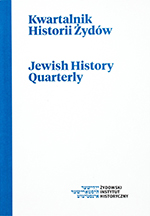W poszukiwaniu światła ukrytego. Problemy dwujęzycznej hebrajsko-polskiej edycji Sefer ha-bahir
The Search for the Hidden Light. Problems with Bilingual Hebrew-Polish Edition of Sefer ha-bahir
Author(s): Wojciech Brojer, Jan Doktór, Bohdan KosSubject(s): Jewish studies, Jewish Thought and Philosophy, History of Judaism
Published by: Żydowski Instytut Historyczny
Keywords: Kabbalah; esoterism; Talmud; light
Summary/Abstract: This year we are planning to publish the Sefer ha-bahir treatise in a bilingual, Hebrew-Polish version. The text is to be preceded by a foreword explaining the circumstances in which the treatise was born and presenting an ideological panorama of Judaism of those times, supplemented by essays concerning the theology, vocabulary and subsequent impact of the treatise on the religious life of the Jews of the Polish diaspora. This plan involves a number of problems that have to be resolved by the publishers already at the outset. These include first of all the choice of one of the number of versions of the text at the basis of translation and the difficult problem of translating the title of Sefer ha-bahir. The purpose of this article is to present these problems precisely.Sefer ha-bahir is a Hebrew theological text, widely regarded as the first, “foundation” deed, of the Mediaeval Jewish cabal. A closer analysis of Sefer ha-bahir suggests that it was recorded by a group of mystics who until then closely followed the classical principles of oral tradition. About a hundred hand-written copies of the treatise have been preserved, the oldest of them being a manuscript kept in the Bavarian Library in Munich, presumably from the late 13th century. The first printed edition of Bahir appeared in Amsterdam in 1651. That editio princeps was based on a text that differs quite significantly from the Munich version. According to information appearing on the title page, the printing of the work was the initiative of Jews arriving from the Republic of Poland. It subsequently served as the basis of a number of editions all the way until the early 20th century coming from printing shops connected with the Polish diaspora only (Berlin, Jabłoński’s printing house 1706; Szkłów 1784; Lviv 1800; 1830; 1865; Vilnius 1883; 1913). This state of affairs makes it easier for us to decide which version should serve as the basis for the Polish edition of Sefer ha-bahir. Our objective, after all, is not just to enable the reader to get to know this important text and sum up its theology but also to present the version that had the biggest impact on the spiritual life of Polish Jews. A comparison of the Amsterdam edition and the Munich version suggests that the source on which editio princeps was based appears to be older and closer to the text recorded by the Languedoc mystics from the 1st half of the 13th century. The meaning of the word bahir appearing in the title poses a separate problem. Borrowed from the Book of Job (Job 37.21), it is a typical hapax legomenon in the Hebrew Bible. Its meaning is not clear. On two occasions, the phrase ’or bahir (bahir light) appears in the treatise. Nearly all the readers and interpreters of the treatise understand bahir as the adjective “bright” or “shiny”. However, the first interpreter of Sefer ha-bahir, Meir ben Salomon abi Sahula in the text entitled ’Or ha-ganuz (Hidden light, 1335) understands bahir as “covered” or “cloudy”. Modern linguistic studies confirm Sahula’s intuition. A closer analysis of the literary and theological context of the word bahir in the treatise suggests that one should follow these traces and, defying tradition, render the title as “The Book of hidden light”.
Journal: Kwartalnik Historii Żydów
- Issue Year: 257/2016
- Issue No: 01
- Page Range: 65-83
- Page Count: 19
- Language: Polish

